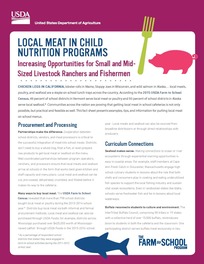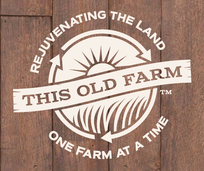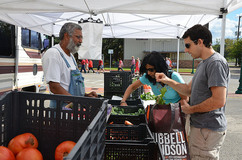Join us for a webinar
on the Farm to School Census
In 2015, USDA completed the second national Farm to School Census
measuring the extent to which schools are purchasing local foods and completing
additional farm to school activities. Results show that during the 2014-2015
school year, 42% of all public school districts, private schools and charter
schools operated farm to school programs. Together, these schools and school
districts purchased almost $800 million of local foods.
Join USDA, along with co-host National Farm to School Network, for a webinar on Thursday, August 11 at 3:00 pm ET for an in-depth review of the Farm to School Census. Presenters
will provide an overview of the Farm to School Census website
including the recently posted raw data files and soon to be released data
explorer tool. Presenters will also describe ways in which Census data can be
used at the local, state, and national levels in support of farm to school.

 Visit us at SNA ANC!
Find us in USDA Lane at booth 2051. We have all of our new fact sheets, pins, temporary tattoos, and stickers. We're here to answer your questions. Please come tell us your farm to school story!
|
Moo-ving beyond fruits and vegetables: Incorporating local meat in child nutrition programs

Policy Memo Clarifies Local Meat Purchasing
Fruits
and vegetables are often gateway products to farm to school programs, but many
districts are filling out their meals with local meat products too! From
buffalo in Montana, chicken in California, to beef in Nebraska, schools are
finding a place for locally raised protein products in the cafeteria. Here are a few highlights of a memo we released last year that outlines
the food safety requirements for purchasing and serving poultry, livestock,
game and eggs in child nutrition programs:
- Livestock must be slaughtered at a
state or USDA inspected facility to be served in child nutrition programs
(CNPs).
- FNS recommends that poultry
be slaughtered at a state or USDA inspected facility to be
served in CNPs, though there are a few exemptions from inspection and
schools could purchase from producers operating under an exemption.
- Wild and domesticated game must
be voluntarily inspected at state or USDA inspected facility to be served
in CNPs.
- Egg products (liquid, frozen,
dried) must be USDA inspected. Shell eggs do not need to be pasteurized.

 Fact Sheet Provides Tips for Buying Local Meat
Opportunities span the meal tray and the calendar year for serving up tasty local meats at lunch, in Summer Meals, and in the pre-K
environments: name the program and local meats have a place on the tray. Here are our top tips for serving up local meat:
- Keep your options open! Meat
used in the National School Lunch Program does not have to come just from
federally inspected sources.
- Some like it raw, some like
it hot (cooked, that is). School Food FOCUS developed resources to help school districts source
raw or pre-cooked antibiotic-free chicken for use in school meals.
- Be brave! Approach a rancher
or processor directly; just pick up the phone and call! You’ll get your
questions answered and may even score some tasty samples.
Check out our Local Meat in Schools Fact Sheet!
|


Grantee Spotlight
This Old Farm,
Inc. is a Food Hub in Colfax, Indiana with a “mission to support the family
farm by processing, marketing, and distributing locally raised, wholesome meat,
produce, and value added food.” Through their FY2015 support service
grant, This Old Farm is offering farm to school solutions by training producers
on topics such as Good Agricultural Practices (GAPs) and crop planning, and
implementing a mentorship program for food service managers on processing and
portion control.
As their grant
has progressed, This Old Farm recognized that in addition to the need for
increased infrastructure around procuring fresh fruit and vegetables, there is
an equal need to support procurement around locally-grown proteins, such as
meat. As a result, This Old Farm began to focus more on protein procurement in
their food service manager mentorship program. Now in their second year of
their grant, they are getting local meat into a local high school culinary
program, two different school districts, and a local youth center. Two schools
that are starting their own beef growing programs are partnering with This Old
Farm for slaughter services. As their grant
moves forward, they are building partnerships to bring local meat into school
districts throughout the region, while continuing to deliver more local fruit and
vegetables to schools in collaboration with the Indiana Farm to School
Network.
This Old Farm reminds us of the importance of being flexible and
of building local partnerships.
Keep up the great work!
|

By Jessica Shahin, Associate Administrator, USDA Food and Nutrition Service
Expanding access to the healthy foods available at farmers markets and farm stands for those participating in the Supplemental Nutrition Assistance Program
(SNAP) has been – and continues to be – a USDA priority. For several
years now, we’ve provided funding to equip farmers markets and direct
marketing farmers with the electronic technology they need to redeem
SNAP benefits. The results speak for themselves. In 2008, there were
only 753 SNAP-authorized markets and farmers. Today, that number has
grown to more than 6,400 – more than eight times the number of
SNAP-authorized farmers markets compared to when the Obama
Administration first took office.
|

|